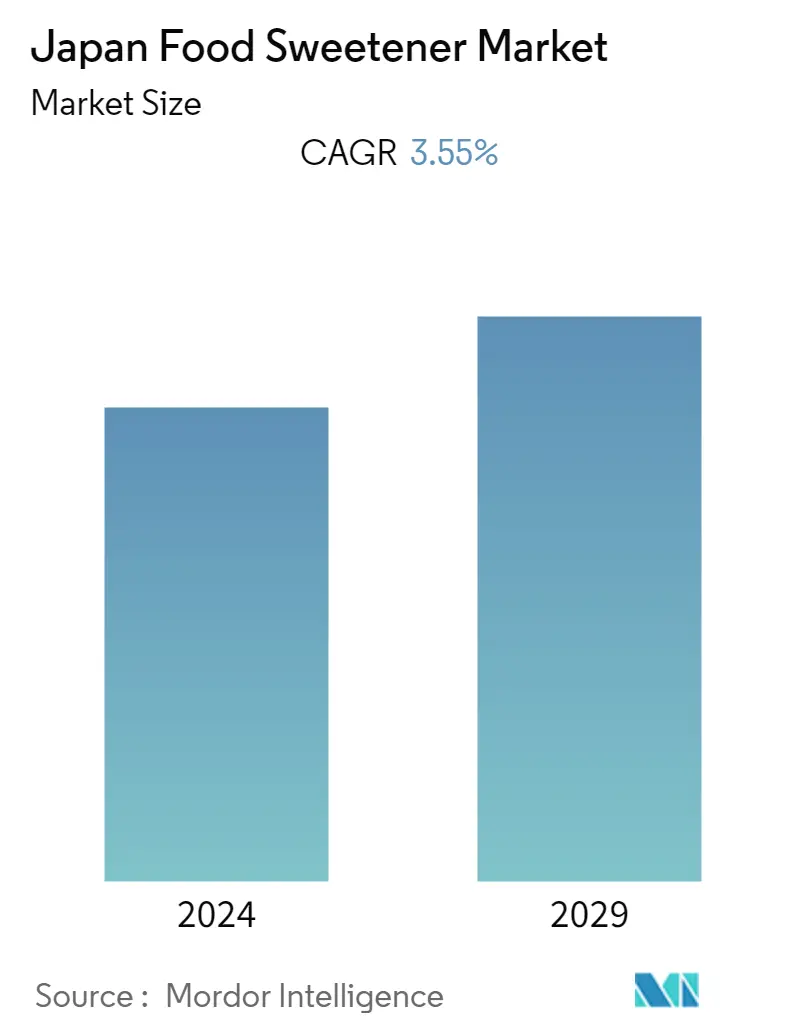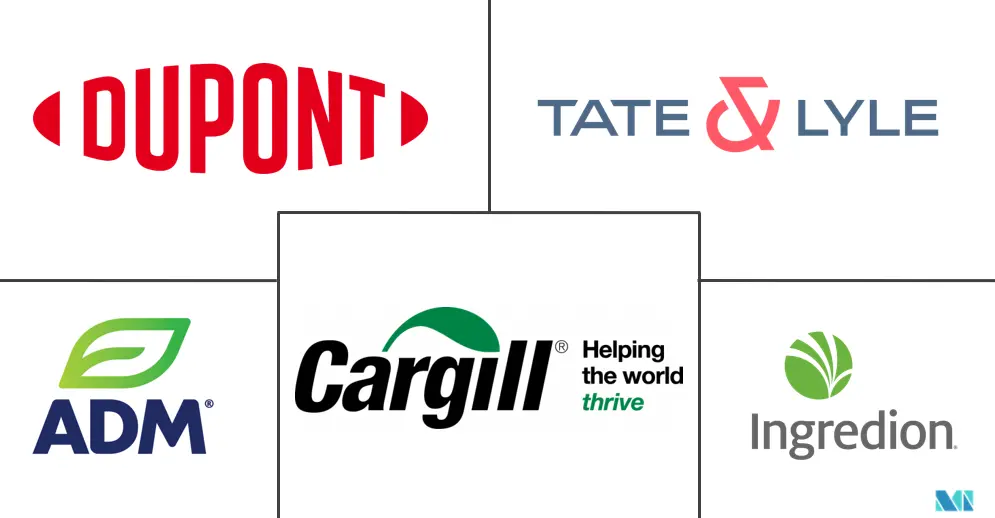Market Size of Japan Food Sweetener Industry

| Study Period | 2019 - 2029 |
| Base Year For Estimation | 2023 |
| Forecast Data Period | 2024 - 2029 |
| Historical Data Period | 2019 - 2022 |
| CAGR | 3.55 % |
| Market Concentration | Low |
Major Players
*Disclaimer: Major Players sorted in no particular order |
Japan Food Sweetener Market Analysis
Japan's food sweetener market is expected to register a CAGR of 3.55% over the forecast period.
- As people become more health-conscious, there has been a growing demand for alternatives to sugar. Many people are looking for low-calorie sweeteners that can provide the same sweet taste without the negative health effects of sugar, such as weight gain and increased risk of diabetes. The inclination toward low-calorie beverages, such as diet Coke and low-calorie drinks, and low-calorie foods, such as yogurt, ice cream, and grain-based desserts, has gained popularity in Japan. With the increasing preferences for natural ingredients, stevia is rapidly growing in the market.
- A high level of sweetener consumption, coupled with the emerging economic status of the country, makes it an attractive market destination. The changing consumer preference drives the demand for healthier, safer food products with high nutritional value. The increased demand for sugar alternatives has led to a higher demand for sweeteners like high fructose corn syrup and tapioca syrup among food and drink manufacturers. Tapioca syrup, in particular, has gained popularity in recent years due to its nutrition-rich properties and gluten-free status.
Japan Food Sweetener Industry Segmentation
Sweeteners are the various natural and artificial substances that impart a sweet taste to foods and beverages.
Japan's food sweetener market is segmented by type and application. Based on the type, the market is segmented into sucrose, starch sweeteners and sugar alcohols, and high-intensity sweeteners (HIS). Starch sweeteners and sugar alcohols are further sub-segmented into dextrose, high fructose corn syrup (HFCS), maltodextrin, sorbitol, and other starch sweeteners and sugar alcohols. The high-intensity sweeteners (HIS) are further sub-segmented into sucralose, aspartame, saccharin, neotame, stevia, cyclamate, acesulfame potassium (Ace-K), and other applications. Based on the application, the market is segmented into bakery and confectionery, dairy and desserts, meat and meat products, soups, sauces and dressings, and other applications.
For each segment, market sizing and forecast have been done based on value (USD million).
| Product Type | ||||||||||
| Sucrose | ||||||||||
| ||||||||||
|
| Application | |
| Bakery and Confectionery | |
| Dairy and Desserts | |
| Beverages | |
| Meat and Meat Products | |
| Soups, Sauces, and Dressings | |
| Other Applications |
Japan Food Sweetener Market Size Summary
The food sweetener market in Japan is experiencing a notable shift as consumers increasingly seek alternatives to traditional sugar, driven by a growing health consciousness. This trend is characterized by a rising demand for low-calorie sweeteners that offer the sweetness of sugar without its associated health risks, such as weight gain and diabetes. The popularity of low-calorie beverages and foods, including diet drinks and sugar-free desserts, is on the rise, with natural ingredients like stevia gaining traction. The market is further bolstered by the economic growth of Japan, which enhances the appeal of sweeteners like high fructose corn syrup and tapioca syrup, known for their nutritional benefits and gluten-free properties. The demand for these alternatives is fueled by changing consumer preferences for healthier, safer food products with high nutritional value.
The market landscape is fragmented, with several key players such as Tate & Lyle PLC, Cargill, Incorporated, Archer Daniels Midland Company, Ingredion Incorporated, and DuPont de Nemours Inc. actively participating. These companies are focusing on innovation and the introduction of low-calorie, natural ingredient-based products to cater to the increasing consumer demand for healthier options. Strategic initiatives like mergers, acquisitions, and new product developments are common as companies aim to enhance their market presence. The trend towards clean-label and organic products is also influencing the market, as consumers prioritize quality and natural ingredients over artificial alternatives. This evolving consumer behavior is driving the growth of the food sweetener market in Japan, with a particular emphasis on products that offer both functional benefits and taste.
Japan Food Sweetener Market Size - Table of Contents
-
1. MARKET DYNAMICS
-
1.1 Market Drivers
-
1.2 Market Restraints
-
1.3 Porter's Five Forces Analysis
-
1.3.1 Bargaining Power of Suppliers
-
1.3.2 Bargaining Power of Buyers/Consumers
-
1.3.3 Threat of New Entrants
-
1.3.4 Threat of Substitute Products and Services
-
1.3.5 Intensity of Competitive Rivalry
-
-
-
2. MARKET SEGMENTATION
-
2.1 Product Type
-
2.1.1 Sucrose
-
2.1.2 Starch Sweeteners and Sugar Alcohols
-
2.1.2.1 Dextrose
-
2.1.2.2 High Fructose Corn Syrup
-
2.1.2.3 Maltodextrin
-
2.1.2.4 Sorbitol
-
2.1.2.5 Xylitol
-
2.1.2.6 Other Starch Sweeteners and Sugar Alcohols
-
-
2.1.3 High-intensity Sweeteners (HIS)
-
2.1.3.1 Sucralose
-
2.1.3.2 Aspartame
-
2.1.3.3 Saccharin
-
2.1.3.4 Cyclamate
-
2.1.3.5 Acesulfame potassium (Ace-K)
-
2.1.3.6 Neotame
-
2.1.3.7 Stevia
-
2.1.3.8 Other High-intensity Sweeteners
-
-
-
2.2 Application
-
2.2.1 Bakery and Confectionery
-
2.2.2 Dairy and Desserts
-
2.2.3 Beverages
-
2.2.4 Meat and Meat Products
-
2.2.5 Soups, Sauces, and Dressings
-
2.2.6 Other Applications
-
-
Japan Food Sweetener Market Size FAQs
What is the current Japan Food Sweetener Market size?
The Japan Food Sweetener Market is projected to register a CAGR of 3.55% during the forecast period (2024-2029)
Who are the key players in Japan Food Sweetener Market?
Tate & Lyle PLC, Cargill, Incorporated, Archer Daniels Midland Company, Ingredion Incorporated and DuPont de Nemours Inc. are the major companies operating in the Japan Food Sweetener Market.

